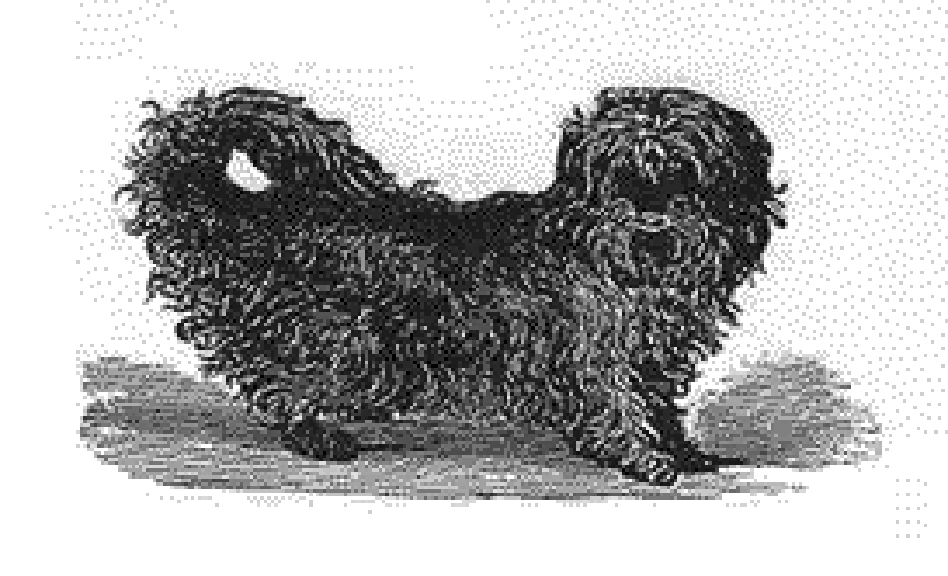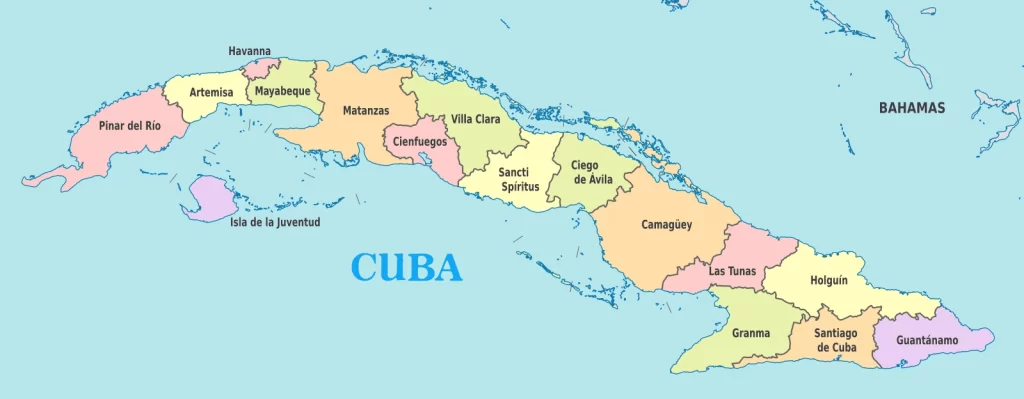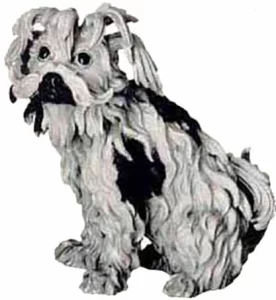Havana Silk Havanese - AKC Breeder of Merit
History of Havanese
Despite being a relatively recent addition to the American Kennel Club (AKC), the Havanese is an ancient breed with a captivating history integral to its unique identity.
1. Small White Dogs
The history of Havanese goes back to the period of 300-600 B.C. Artifacts discovered in Faryum, Egypt reveal the presence of small white dogs. Many historians believe that these dogs, known as the “Blanquito,” were the ancestors of modern small dogs, named for their white color. The indigenous Blanquito dogs of Malta, referred to as “Maltese,” differed from their modern counterparts. They possessed a sturdier build, upright ears, and a coarse coat and appeared in various colors. The term “Blanquito” specifically denoted the white ones, and over time, they became widespread across Europe. Notably, Aristotle (384 BC – 322 BC) mentioned them in Latin texts, while the Romans, captivated by their pristine white coats, favored the Blanquito. Roman Emperor Claudius even owned several of these dogs during his reign (AD 41 – AD 54).

Images of these dogs were a common theme for elaborately decorated Roman vases, as shown in the example above.
2. Small Soft-Coated Dogs
Throughout history, Blanquito has undergone transformations, resulting in increasingly softer coats, including silky and curly (resembling cotton) varieties. The term “Barbichon,” and its shortened version, “Bichon,” originated from the French word meaning “soft-coated.” The modern Bichon breed is believed to have originated from a Spanish Blanquito with a curly coat known as the “Tenerife,” named after its place of origin, the Tenerife island.
The original Bichon-Blanquitos served as the foundation for developing various breeds, each reflecting the distinct characteristics of their respective homelands. While the French Bichon Frisé remains the most famous, the Bichon group currently encompasses the Bolognese, Coton De Tulear, Havanese, Löwchen, Maltese, and Russian Tsvetnaya Bolonka. Each breed within the Bichon group has acquired its distinct appearance and temperament through closely associating with its native geographical region.
Individual breeds within the Bichon group vary slightly in appearance, but all have tails curled over their back, a coat that is hair rather than fur (non-shedding), drop ears, pointed though slightly shortened snouts, and large dark eyes.

Black Bichons, like the one depicted in the engraving above, were considered undesirable and prohibited in European show rings until the end of the 20th century. Today’s Havanese coat comes in various colors, including black, all equally acceptable in the show ring.
3. Small Cuban Dogs
During the era known as the “Age of Exploration,” spanning from the early 15th century to the early 17th century, Europeans embarked on maritime expeditions to explore the world. In November of 1492, Christopher Columbus hoisted the flag of Spain for the first time over Cuba, marking the beginning of European colonization on the island. Spain maintained control over Cuba for the majority of the ensuing four centuries. As these explorers set sail on extended voyages, they brought along Bichon-Blanquito dogs to combat rodents and provide entertainment for the sailors. Upon reaching their destinations, these dogs were presented as gifts to gain favor and trust among the aristocratic classes. Only the most resilient dogs could endure the demanding and lengthy journeys, while only the most affectionate and responsive ones could secure acceptance among the aristocracy. Any dog displaying impolite behavior would certainly have failed to fulfill its purpose or survive the voyage.

As highly coveted and treasured presents, Havanese gained immense popularity among the privileged class in Cuba. Known as the “Blanquito Cubano,” they gradually transformed into a smaller variant of their ancestors. Possessing a petite stature, an alert expression, and a loving disposition, these adorable and silky canines perfectly aligned with the emerging Cuban preferences for white attire, delicate cuisine, lavish manners, and appealing aesthetics. Since the breed originated in Cuba under the care of aristocratic owners of expansive sugar plantations, puppies were never intended for commercial transactions. Instead, they were meticulously planned to be gifted exclusively to close friends and beloved family members.
National Dog of Cuba
The Havanese, Cuba’s sole native breed, holds the prestigious title of the “National Dog of Cuba.” Throughout history, these charming dogs have been sought after and exported to various nations, often presented as gifts to nobles and esteemed individuals. In the 18th century, the Havanese made its grand entrance into England, capturing the hearts of prominent figures such as the Queen of England, who owned two of these delightful canines, and the renowned author Charles Dickens, who also cherished one.

The breed’s name, “Havanese,” derives from its place of origin: Havana, Cuba. Over the centuries, the Havanese has been known by various names, including Blanquito Cubano, Bichon Habanero, Bichon Havanais, Bichon of Cuba, White Cuban, Blanquito de la Habana, Havana Silk Dog, and Spanish Silk Poodle, among others. However, all these names refer to a single distinctive breed that was originally developed in Cuba and enjoyed great favor among the aristocratic sugar barons of the time.

An exquisite representation of this beloved breed can be observed in the Meissen porcelain statue depicted above, originating from Germany around 1770.
But then… Near Extinction
The communist revolution in Cuba, spanning from 1958 to 1960, had a devastating impact on the Havanese breed. Numerous affluent individuals hastily fled the island to safeguard their lives, with the intention of returning once the violence subsided. Regrettably, the majority of these individuals were unable to reclaim their homes, leaving behind many dogs to fend for themselves. These abandoned Havanese dogs either perished from starvation or roamed the streets in search of scraps. Consequently, the Cuban Havanese and their pedigrees were on the verge of extinction. Only three families managed to successfully escape Cuba with their Havanese companions: the Perez and Fantasio families, who relocated to the United States, and Senior Barba, who settled in Costa Rica.
How an American rescued Havanese
In the early 1970s in the United States, Dorothy Goodale and her husband, Burt, embarked on a mission to revive the Havanese breed. Their objective was to locate and acquire as many purebred Havanese dogs as possible. After years of persistent investigation into scarce references about these small canines, they stumbled upon an advertisement featuring six pedigreed Havanese. These dogs represented the Perez and Fantasio families, which were two unrelated bloodlines.
Mrs. Goodale continued her efforts to purchase Havanese by placing advertisements in Latin American newspapers. Only one other person responded to her request: Senior Barber from Costa Rica, who agreed to sell five Havanese to the Goodales. As a result, by 1974, Goodale’s Havanese breeding program was established with eleven dogs from three unrelated bloodlines.

In 1979, Mrs. Goodale (photo above) founded the Havanese Club of America alongside a small group of newly involved breeders and supporters. They established an official registry for the breed. Through careful and selective breeding, the Havanese population grew, eventually reaching a size that allowed them to petition the United Kennel Club for breed registration in 1980.
Finally, in 1996, the first Havanese dog entered an American Kennel Club (AKC) show ring and was accepted as a member of the Toy Group on January 1, 1999. Recently, the International Federation reinstated the Havanese as Cuba’s national dog, recognizing it as the country’s sole native breed. Today, it is estimated that over 4,000 Havanese dogs are owned in the United States, with more than 7,000 worldwide.
Throughout history, Havanese dogs have remained delightful companions known for their gentle, easy-going nature and cheerful disposition. They were initially bred to be close companions to people, and their intelligence and adaptable nature made them popular as circus performers in the past. Havanese dogs enjoy learning and performing tricks, eagerly exchanging their talents for affection and treats.
They generally enjoy long and healthy lives. Instead of displaying aggression towards other dogs, Havanese thrive when they have ample opportunities for socializing with their furry friends. They particularly enjoy the company of other Havanese dogs, and owners often organize Havanese parties where these dogs quickly form instant friendships. Havanese dogs are sociable and friendly yet possess a submissive side. They form strong bonds with their entire family and are happiest when they are in the presence of their loved ones. Havanese dogs exemplify gentleness and unwavering loyalty, making them the ultimate small dog companions.
